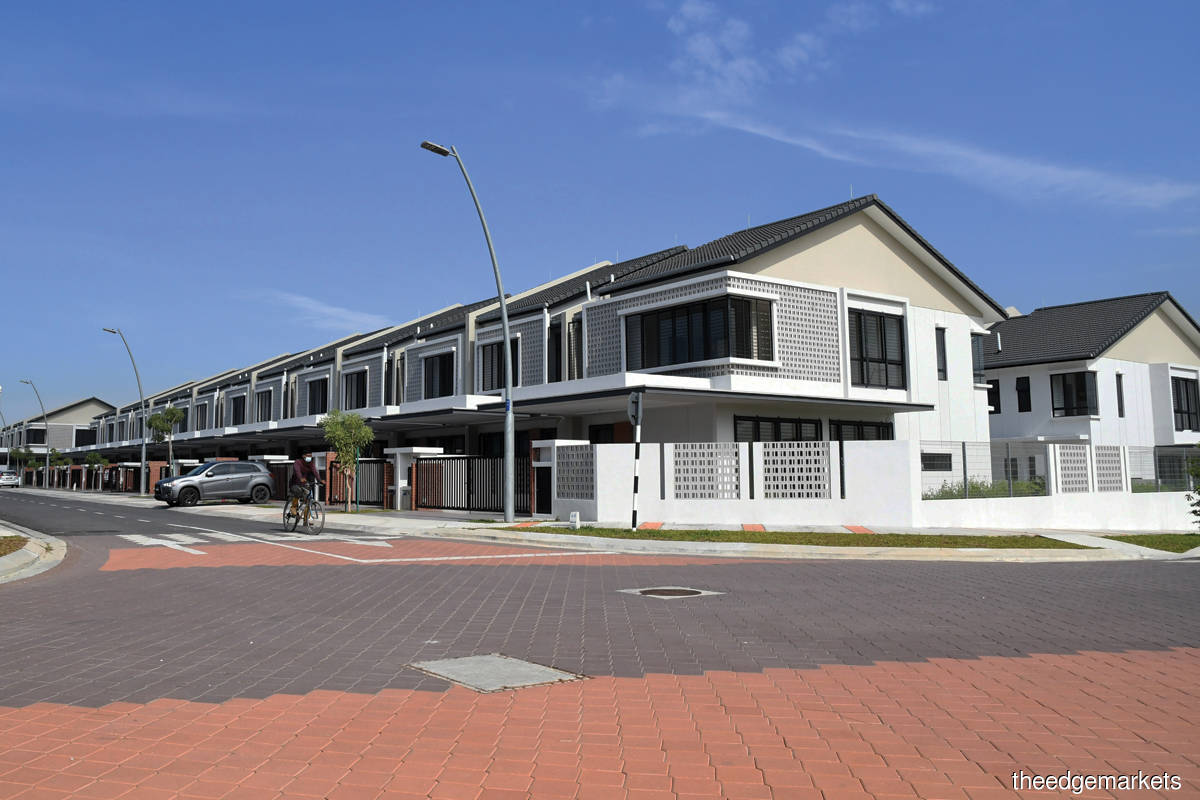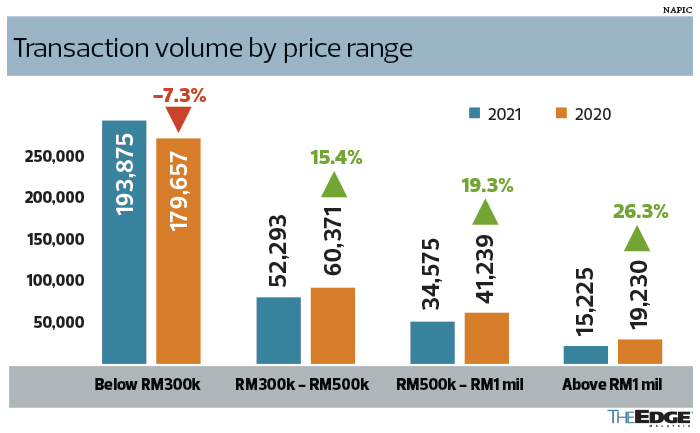Stamp duty waiver will not lift market out of doldrums, experts say

PUTRAJAYA’s stamp duty waiver for first-time homes worth not more than RM1 million may have brought some cheer to a subdued property market. However, the incentive is a long shot from resolving the deeper troubles in the sector, such as the overhang of unsold units, say industry experts.
Prime Minister Datuk Seri Ismail Sabri Yaakob on July 15 announced a full stamp duty waiver for those buying homes costing up to RM500,000 and half-exemption for homes from RM500,001 to RM1 million from June 1 this year until the end of 2023, under a new initiative called Keluarga Malaysia Home Ownership Initiative (i-MILIKI).
The waiver involves tax imposed on documents in the sale or transfer of a first property through the house pricing tier, as well as a supporting document — Memorandum of Transfer (MOT), also known as instrument of transfer.
“The waiver of stamp duty until 2023 will definitely help to motivate first-time homebuyers, especially in the lower income group, as the MOT cost is not always part of the housing loan,” says a senior property executive who asked not to be named.
“Still, the sales conversion is very much dependent on the ability of the homebuyers to obtain a loan for their desired property, where currently, most buyers for houses below RM500,000 rely on 90% financing or higher,” he tells The Edge.
Some analysts contend that the impact on the overall property market will be minimal as ongoing market headwinds, such as rising inflationary pressure and weakening of the ringgit, continue to dampen market sentiment.
In a July 18 note, RHB Research senior analyst Loong Kok Wen says while demand, especially for properties priced under RM500,000, may be spurred slightly, potential homebuyers are likely to defer their purchase of big-ticket items in the next six months given the expectation of higher interest rates ahead.
Loong, who maintains a “neutral” call on the sector, notes that some property developers are still offering stamp duty waivers, discounts and freebies for slow-moving property units as a continuation of the government’s Home Ownership Campaign (HOC), which was launched on Jan 1, 2019, and relaunched several times until it ended at the end of last year.
Meanwhile, property consultants point out that the waiver is confined to first-time homebuyers in the primary market only, which will result in an even smaller impact compared with the earlier stamp duty waiver granted during the HOC, which gave successful applicants a full exemption for home purchases up to RM1 million, and a partial discount of stamp duty of 3% for properties worth between RM1 million and RM2.5 million.
They also note that the incentive is being introduced at a time when pay raises are unlikely in the current economy, and even if individuals enjoy a higher salary, it is not sufficient to spur demand in the sector.
In a July 18 note, Maybank Research analyst Wong Wei Sum says a muted impact from the latest initiative is expected given that the 50-basis-point (bps) overnight policy rate hike could hit buyers’ affordability.
“A 3% jump in monthly instalment is expected for every 25bps hike in interest rate,” says Wong, who maintains a “neutral” call on the sector and has “buy” calls on Eco World Development Group Bhd and Sime Darby Property Bhd.
RHB’s Loong believes that potential beneficiaries of the incentive include Mah Sing Group Bhd, LBS Bina Group Bhd, Matrix Concepts Holdings Bhd and Tambun Indah Land Bhd due to their relatively high exposure (above 60%) to property products priced below RM500,000.
“Almost 100% of Matrix’s developments, for instance, are matured townships where the upfront infrastructure and landscaping costs will be minimal compared with starting a new township. IOI Properties Group Bhd, on the other hand, is a strong asset owner, which will see the company’s retail segment boosted with the reopening of international borders,” she says.
However, Loong believes potential benefits to the bigger players may be immaterial given that “mid-range products make up only a smaller percentage of their overall portfolio”.
Still, the introduction of i-MILIKI has led to some confusion among analysts and industry players over the stamp duty waiver’s ending period. In Budget 2021, the stamp duty waiver for the purchase of first homes valued up to RM500,000 is applicable for sales and purchase agreements (SPAs) executed between Jan 1, 2021, and Dec 31, 2025.
“For houses below RM500,000, we are sticking to the waiver’s expiry date of December 2025, and with i-MILIKI, houses priced from RM500,001 to RM1 million receiving the half-exemption until the end of next year,” the senior property executive says.
Long-term solution needed to address overhang, affordability key
Data from the National Property Information Centre show that the first quarter of 2022 (1Q2022) saw a residential property overhang of 35,592 units across the country, collectively worth RM22.45 billion.
Of this total, 10,158 units were priced below RM300,000, 10,501 within the RM300,000 to RM500,000 price range, 10,227 within RM500,000 to RM1 million, and 4,706 above RM1 million. States with high overhang volumes were Johor, Penang, Kuala Lumpur and Selangor, with more than half of the unsold units being high-rise properties, followed by nearly equal numbers of terraced housing and other residential properties.
It is worth noting that in the same period, 2,936 residential units (2,657 landed; 279 high-rise) were launched, but only 164 units or 5.4% were sold. States that saw high volumes of launches were Johor, followed by Melaka, Pahang, Kuala Lumpur and Selangor.
Datametrics Research and Information Centre Sdn Bhd managing director Pankaj C Kumar cautions that while incentives such as the ongoing stamp duty waiver are seen to be a boon for genuine homebuyers as well as for developers to push their unsold units, the move may perpetuate the vicious cycle of supply outstripping demand.
“We don’t want a situation where the government’s push by way of such waivers encourages developers to keep launching their products, and buyers keep snapping them up, ultimately exacerbating the vicious cycle of a property overhang. This is an existing issue which needs to be addressed over the long term,” he tells The Edge.
He adds that the current oversupply of properties is a structural issue, requiring the ecosystem of developers, local councils, bankers, valuers and consultants to resolve. “It takes a long time to settle and certainly cannot be resolved by short-term measures [such as buyer incentives].”
Time for developers to ‘bite the bullet’
CBRE | WTW Malaysia group managing director Foo Gee Jen is of the view that developers need to reconsider how best to price their products affordably in an ailing market.
“Players with new offerings will really need to get down to the basics and think only about putting roofs over heads. It will not be about lavish finishing and facilities but about selling at affordable prices,” he says.
Asked whether property prices have already bottomed out, he believes that real estate in prime locations will maintain their prices. However, unsold properties in poor locations may face further depreciation.
“That said, I do not foresee a hard landing in the market given the ultra-low interest rate regime happening now, which has stabilised prices. Any market correction should be minimal. I believe there will be organic growth [in the property market] over the next year or two — that is, if the economy does not experience a strong [growth] surge. After all, there is pent-up demand and urbanisation as dwellers move to first- and second-tier cities,” says Foo.
Cost pressures continue to weigh on developers as building material prices remain high amid unresolved labour shortage woes, spelling a potential downside risk to developers’ earnings in the coming quarters, RHB’s Loong says.
“As developers have invested heavily in land and machinery, developments will carry on in spite of the prevailing high input costs. And I believe property players will be sensible enough to withhold from passing the higher costs to consumers. But in order to maintain sales, selling prices will need to be adjusted,” CBRE’s Foo says.
“This is a time developers will have to bite the bullet and accept reduced profit margins. Some developers have said they expect their profit margins to fall from the 20% to 25% region to the 8% to 10% level,” he says, adding that he expects market conditions to “normalise” in the next two years.
“With improvements to the light rail system and construction of the Johor Baru–Singapore Rapid Transit System and the Penang Transport Master Plan to ease connectivity, I hope the country will move towards owning a property rather than a car. Families don’t need to have so many vehicles. This, I believe, would be the silver lining [in the property market], and as to how the nation can move forward,” he says.
The content is a snapshot from Publisher. Refer to the original content for accurate info. Contact us for any changes.
Related Stocks
Comments


